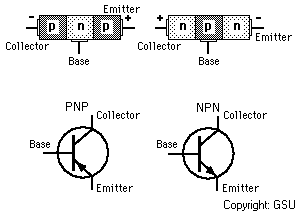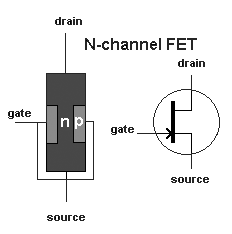How does a Transistor works.........?
There are two main types of transistors-junction transistors and field effect transistors. Each works in a different way. But the usefulness of any transistor comes from its ability to control a strong current with a weak voltage. For example, transistors in a public address system amplify (strengthen) the weak voltage produced when a person speaks into a microphone. The electricity coming from the transistors is strong enough to operate a loudspeaker, which produces sounds much louder than the person's voice.
JUNCTION TRANSISTORS
 A junction transistor consists of a thin piece of one type of semiconductor material between two thicker layers of the opposite type. For example, if the middle layer is p-type, the outside layers must be n-type. Such a transistor is an NPN transistor. One of the outside layers is called the emitter, and the other is known as the collector. The middle layer is the base. The places where the emitter joins the base and the base joins the collector are called junctions.
A junction transistor consists of a thin piece of one type of semiconductor material between two thicker layers of the opposite type. For example, if the middle layer is p-type, the outside layers must be n-type. Such a transistor is an NPN transistor. One of the outside layers is called the emitter, and the other is known as the collector. The middle layer is the base. The places where the emitter joins the base and the base joins the collector are called junctions.
The layers of an NPN transistor must have the proper voltage connected across them. The voltage of the base must be more positive than that of the emitter. The voltage of the collector, in turn, must be more positive than that of the base. The voltages are supplied by a battery or some other source of direct current. The emitter supplies electrons. The base pulls these electrons from the emitter because it has a more positive voltage than does the emitter. This movement of electrons creates a flow of electricity through the transistor.
The current passes from the emitter to the collector through the base. Changes in the voltage connected to the base modify the flow of the current by changing the number of electrons in the base. In this way, small changes in the base voltage can cause large changes in the current flowing out of the collector.
Manufacturers also make PNP junction transistors. In these devices, the emitter and collector are both a p-type semiconductor material and the base is n-type. A PNP junction transistor works on the same principle as an NPN transistor. But it differs in one respect. The main flow of current in a PNP transistor is controlled by altering the number of holes rather than the number of electrons in the base. Also, this type of transistor works properly only if the negative and positive connections to it are the reverse of those of the NPN transistor.
FIELD EFFECT TRANSISTORS
 A field effect transistor has only two layers of semiconductor material, one on top of the other. Electricity flows through one of the layers, called the channel. A voltage connected to the other layer, called the gate, interferes with the current flowing in the channel. Thus, the voltage connected to the gate controls the strength of the current in the channel. There are two basic varieties of field effect transistors-the junction field effect transistor(JFET) and the metal oxide semiconductor field effect transistor (MOSFET). Most of the transistors contained in today's integrated circuits are MOSFETS's.
A field effect transistor has only two layers of semiconductor material, one on top of the other. Electricity flows through one of the layers, called the channel. A voltage connected to the other layer, called the gate, interferes with the current flowing in the channel. Thus, the voltage connected to the gate controls the strength of the current in the channel. There are two basic varieties of field effect transistors-the junction field effect transistor(JFET) and the metal oxide semiconductor field effect transistor (MOSFET). Most of the transistors contained in today's integrated circuits are MOSFETS's.
There are two main types of transistors-junction transistors and field effect transistors. Each works in a different way. But the usefulness of any transistor comes from its ability to control a strong current with a weak voltage. For example, transistors in a public address system amplify (strengthen) the weak voltage produced when a person speaks into a microphone. The electricity coming from the transistors is strong enough to operate a loudspeaker, which produces sounds much louder than the person's voice.
JUNCTION TRANSISTORS
 A junction transistor consists of a thin piece of one type of semiconductor material between two thicker layers of the opposite type. For example, if the middle layer is p-type, the outside layers must be n-type. Such a transistor is an NPN transistor. One of the outside layers is called the emitter, and the other is known as the collector. The middle layer is the base. The places where the emitter joins the base and the base joins the collector are called junctions.
A junction transistor consists of a thin piece of one type of semiconductor material between two thicker layers of the opposite type. For example, if the middle layer is p-type, the outside layers must be n-type. Such a transistor is an NPN transistor. One of the outside layers is called the emitter, and the other is known as the collector. The middle layer is the base. The places where the emitter joins the base and the base joins the collector are called junctions.The layers of an NPN transistor must have the proper voltage connected across them. The voltage of the base must be more positive than that of the emitter. The voltage of the collector, in turn, must be more positive than that of the base. The voltages are supplied by a battery or some other source of direct current. The emitter supplies electrons. The base pulls these electrons from the emitter because it has a more positive voltage than does the emitter. This movement of electrons creates a flow of electricity through the transistor.
The current passes from the emitter to the collector through the base. Changes in the voltage connected to the base modify the flow of the current by changing the number of electrons in the base. In this way, small changes in the base voltage can cause large changes in the current flowing out of the collector.
Manufacturers also make PNP junction transistors. In these devices, the emitter and collector are both a p-type semiconductor material and the base is n-type. A PNP junction transistor works on the same principle as an NPN transistor. But it differs in one respect. The main flow of current in a PNP transistor is controlled by altering the number of holes rather than the number of electrons in the base. Also, this type of transistor works properly only if the negative and positive connections to it are the reverse of those of the NPN transistor.
FIELD EFFECT TRANSISTORS
 A field effect transistor has only two layers of semiconductor material, one on top of the other. Electricity flows through one of the layers, called the channel. A voltage connected to the other layer, called the gate, interferes with the current flowing in the channel. Thus, the voltage connected to the gate controls the strength of the current in the channel. There are two basic varieties of field effect transistors-the junction field effect transistor(JFET) and the metal oxide semiconductor field effect transistor (MOSFET). Most of the transistors contained in today's integrated circuits are MOSFETS's.
A field effect transistor has only two layers of semiconductor material, one on top of the other. Electricity flows through one of the layers, called the channel. A voltage connected to the other layer, called the gate, interferes with the current flowing in the channel. Thus, the voltage connected to the gate controls the strength of the current in the channel. There are two basic varieties of field effect transistors-the junction field effect transistor(JFET) and the metal oxide semiconductor field effect transistor (MOSFET). Most of the transistors contained in today's integrated circuits are MOSFETS's.



Tidak ada komentar:
Posting Komentar